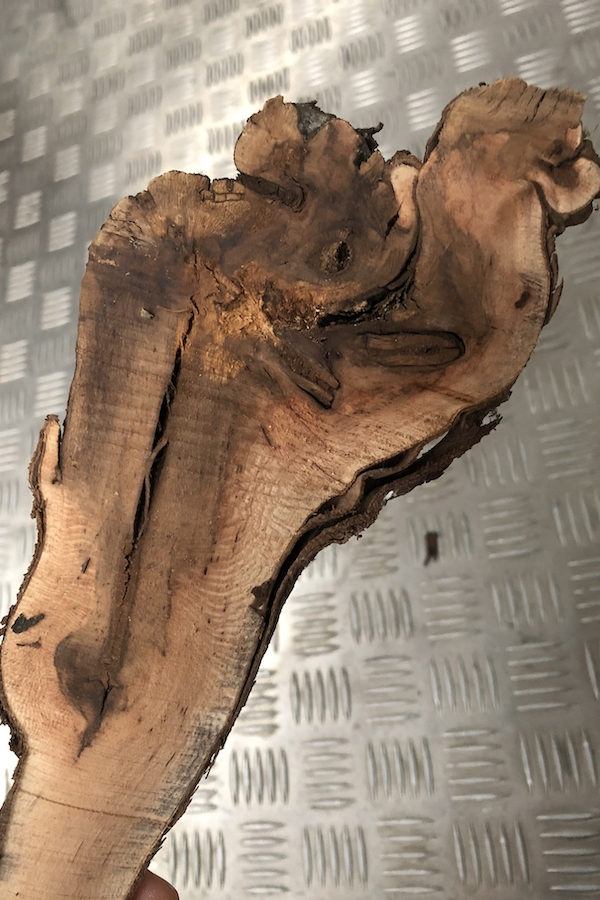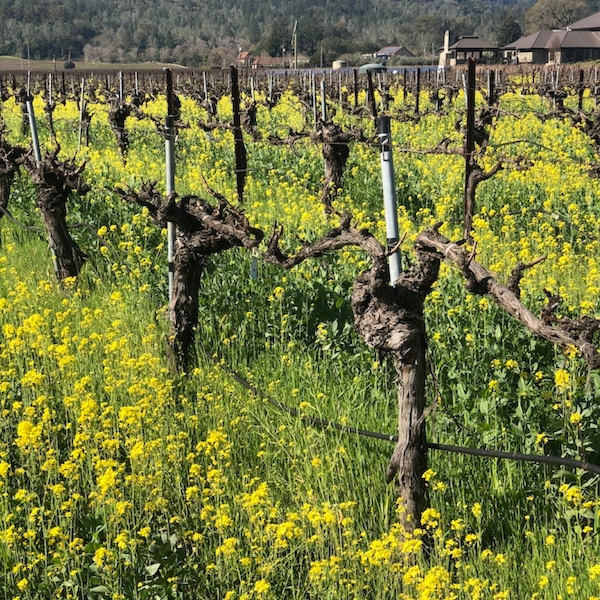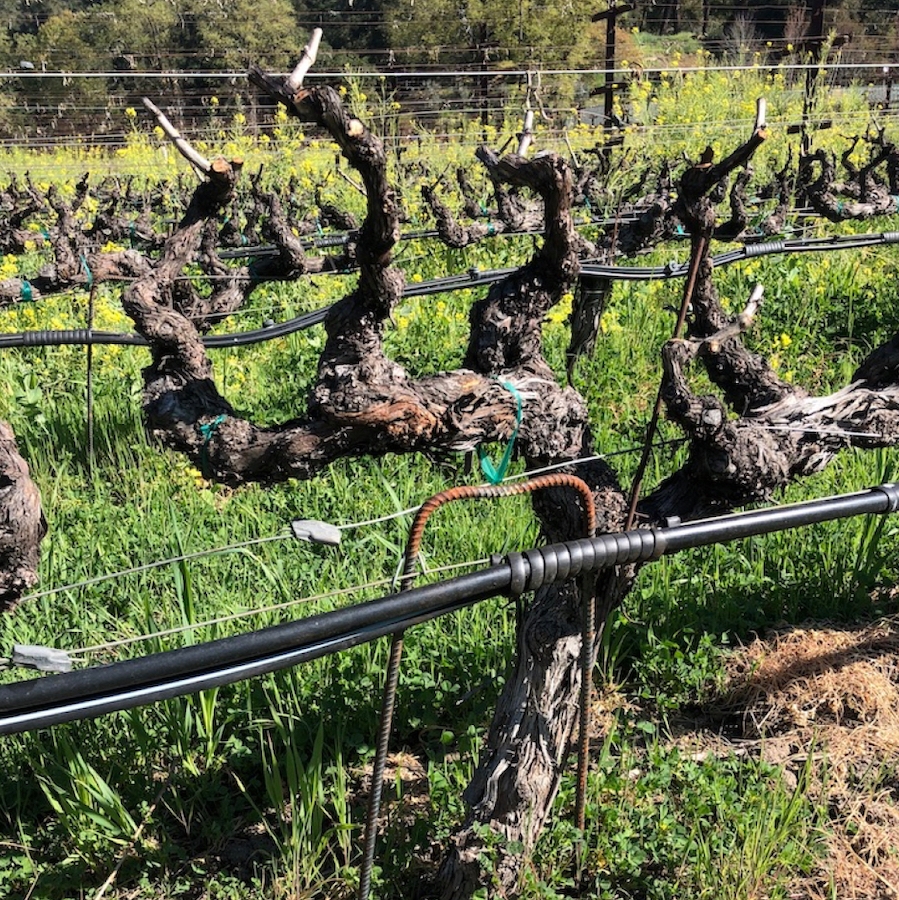Published on GuildSomm.com:
In the vineyard, trunk diseases are spread through fungal pathogens that enter the wood through wounds, most often from pruning but also from other mechanical injuries to the vine. The diseases can metastasize over time, resulting in symptoms that include dead spurs and stunted shoots, as well as internal wood symptoms that can be seen via cross-sectional cuts on permanent wood. These can lead to the partial or total death of the vine. The most prevalent trunk diseases globally are Esca and Eutypa dieback. (While these are the focus of this article, it’s important to note that other diseases, such as Botryosphaeria dieback and Phomopsis dieback, are also common in certain regions.) The economic impact of these diseases is seen in dramatic yield reductions and, ultimately, loss of the vine. Recent estimates indicate that properties can lose 10 to 20% of their vines in a season once affected.
To address this major challenge, specific pruning methods that focus on sap flow are increasingly being implemented, with the aim of helping to extend the life of vineyards by preserving pathways for nutrients to sustain the vine. This article will outline the diseases these practices confront and examine the methods themselves, including their history, associated challenges, and sustainability.
Dead wood (dieback) is marked by the darker brown visible in this cross section (Photo credit: Sarah Bray)
Knowing the Threat
Esca is a trunk disease that thrives in cooler climates in Europe, although its presence is increasing in warmer regions. Visual identifiers include leaves with interveinal coloring—reddish brown in red varieties, yellowish in white varieties—with a stark margin outlining the indication of necrosis. In some cases, there are fruit spots, known as black measles, and concentric rings of black spots within the wood. Esca is transmitted via a variety of pathogens such as the Phaeoacremonium species, with spores released during rain episodes, which are common during the winter pruning season. It affects sensitive vines: Cabernet Sauvignon and Sauvignon Blanc are two of the most widely affected, as are other genetically related varieties. However, the disease has been seen in vines across Europe, from Pinot Noir and Chardonnay to Riesling and Corvina.
Eutypa dieback, a major issue throughout California, Australia, South Africa, and other warmer growing regions, is a result of exposure to Eutypa lata and other similar species of fungi. Visual identifiers include stunted shoots with deformed leaves and shortened internodes, as well as wedge-shaped cankers within the wood. Eutypa dieback is also known as “dead arm,” an apt descriptor of the most affected cordon-trained vines with their leafless spurs, and it is predominantly associated with its impact on Cabernet Sauvignon and its family of grapes.
According to Roberto Merlo of Uva Sapiens S.r.l., a viticultural and winemaking consultancy based in Italy, the two diseases are brought on by different conditions. Esca is predominantly a product of its environment—“frequently where the climate is medium-humid, like mid-Europe,” he notes—while Eutypa has a more human cause. Merlo explains, “For Eutypa, pruning quality is the really important [factor]; when you start to have this kind of disease, it’s more or less related to the pressure in the place and/or the number of significant wounds that have been made in the vineyard.” Winter pruning is a fundamental component to this discussion, as the act of cutting back the previous year’s growth lays the groundwork for disease to enter and affect the live wood, in addition to shaping the vine over time.
Disease Prevention and Management
When it comes to vine diseases, prevention is top of mind with new vineyard plantings, as Marco Simonit of Simonit & Sirch notes. “It’s important to start the young plants off on the right foot,” he says, “in order to successfully create sustainable, strong, long-lived plants that will adapt well to climatic variations.” His company, which is also based in Italy, is one of the best-known viticultural consultancies worldwide espousing the methods of pruning to preserve sap flow.
In areas like Australia’s Yarra Valley, which is battling the influx of phylloxera, there is a lot of new planting occurring. Producers like Giant Steps, as its viticulturalist Ashley Wood explains, are looking to protect the health of vines from the beginning of their lives. Wood is looking at how to best ensure longevity and productivity in his vineyards, which are in an area where Eutypa is also a concern.
 Cross-section of a dead vine, showing how the sap flow was impeded by the dead wood (Photo credit: Sarah Bray)
Cross-section of a dead vine, showing how the sap flow was impeded by the dead wood (Photo credit: Sarah Bray)Once present, Esca and Eutypa dieback are nearly impossible to eradicate, so preventative measures are crucial. These can include delayed pruning (wounds heal more readily as sap begins to flow); painting pruning wounds with fungicides like VitaSeal, ; and utilizing clean pruning shears and equipment, as cutting diseased wood infects the blades, which become a vector for passing disease to adjacent vines. The fungus can quickly affect multiple vines in a site, amplified in the denser plantings of modern trellising systems.
Management in severely infected vineyards can extend to sanitation, wherein dead spurs or cordons are cut away. Alternatively, vine surgery can facilitate a new sucker, the small shoot that a grapevine trunk puts out in the spring. Here, the sucker will be trained up to become a replacement trunk, and the infected wood will be entirely removed. Simonit explains, “When you perform an autopsy on a dead or dying vine, you find lots of black, dead wood, and a tiny bit of live wood. [Pruning] cuts, both big and small, have closed off the pathway for nutrients, resulting in weak shoots. When it’s completely dead and dried out, it’s because the wounds closed the road for the lymph.” Infected wood must be removed from the vineyard immediately or burned, as the spores are still present in the wood and can be released into the vineyard with a rain event. When a vine is heavily impacted, there’s often little to do but grub up and replant.
Respect the Sap Flow
A growing number of viticulturists believe that at the foundation of combating these problems is the idea of changing the way vines are pruned. These wounds are also where diseases can enter the vine.
Instead, the philosophy of that respects the vine’s vascular system, called soft pruning, essentially seeks to keep the wounds to one side and advises smaller cuts away from the live wood, which can be cut back later, after the wood has fully dried out and therefore won’t impact the sap flow. The method, once explained, is a rather straightforward concept: by containing pruning to the same side of the vine, and making small cuts further away from the vine, the sap flow is not disturbed, and the dieback and any pathogens are limited in their impact. This method works across a variety of trellising systems the world over, although it was originally conceived in the 1860s by Charles Guyot, after whom the Guyot-Poussard technique is named.
Simonit came upon this realization organically through observations beginning in 1988, first working in the Collio region and then through extensive travel, looking at plants that aged well, asking why other vines were getting sick, and examining whether there was a relationship between the wounds and dead wood. Growers in Friuli, where he was based, gave him access to vineyards where he began to implement the concept he’d gathered during his travels: to embrace the vine’s natural tendency as a creeper by allowing it to create branches. Simonit observed the success of old bush-trained vines, called “little trees,” or alberelli, in Italian. He notes, “I coined the term ramificazione (branching) . . . because after the trunk, the main structure, we have to build the secondary structure that with time must grow—we must not cut it off. And this was the exact opposite of what they taught you in school.” Only later, once connected to the University of Bordeaux’s Denis Dubourdieu, was he made aware of Poussard’s pruning method developed a century prior.
Working with a similar methodology, Uva Sapiens was established in 2013 after several years of its team loosely working together. According to Merlo, “Poussard is the method we apply both in cane and spur pruning, and we encourage winegrowers to respect sap vessel integrity with the aim to allow the plant to grow without physical constraints that could limit its physiological activity.” The focus of Uva Sapiens with regards to controlling trunk disease is first prevention, and then treatment for already affected vines. These two companies are leading a major shift in the approach to premium-level vineyard management worldwide, working with clients in Germany, Austria, Spain, California, Australia, South Africa, and beyond, in addition to their home in Italy.
Producers See the Benefits
Extending the life of vineyards is the primary motivation for most producers in reaching out to these consultants or researching and applying their practices. Cathy Corison of the Napa Valley, where Eutypa is a major issue, has been pruning with Simonit & Sirch for four years, specifically with the intention of extending the life of her Kronos Vineyard. “Our estate vineyard surrounding the winery was planted in 1971, so it is turning 50 years old this year,” she explains. “With Marco’s help, I hope we’re entering the vineyard’s second half-century. The gnarly old ladies in Kronos have been rejuvenated!”
Andrea Lonardi, Chief Operations Officer for Bertani Vineyards in Italy, which owns and produces wine from the Veneto, Friuli, Tuscany, and the Marche, had seen a particularly heavy impact of Esca on the plantings of Corvina, Sauvignon Blanc, and Sangiovese—key grapes in these regions. He sought help from Simonit & Sirch, and Bertani worked directly with the company for several years. Lonardi still implements many of their ideas across the vineyards. He notes that while Esca was the impetus for seeking out and implementing these methods, the results go beyond management, albeit not eradication, of the disease: “We have better balance in the vineyard, earlier ripening given this balance, and more homogenous results.”
 Corison’s Kronos Vineyard of Cabernet Sauvignon in the Napa Valley (Photo credit: Sarah Bray)
Corison’s Kronos Vineyard of Cabernet Sauvignon in the Napa Valley (Photo credit: Sarah Bray)Better balance in the fruit is a bonus, one that premium producers regard with satisfaction. Johannes Hirsch of Hirsch Vineyards in the Kamptal, Austria, began working with Simonit & Sirch after a visit to Italy in 2012, reacting to the overall health of the vineyards he witnessed. “I’ve never seen better balanced vineyards and grapes than [those] at the farmers [that] started to use that technique around 1988,” Hirsch notes. While implementation is expensive, he is convinced of its value. “I am totally sure that almost all vines . . . will become much older, be much better resistant, bring much better physiological ripeness. In relation, it’s a small investment for the future.”
The Napa-based winemaker Maya Dalla Valle brought Uva Sapiens in three years ago to work with her year-round, in-house vineyard team. She has also noted a marked improvement in overall vineyard health and balance, and an impact on her team as well. Dalla Valle studied in Bordeaux and worked at wineries such as Tuscany’s Ornellaia, where she witnessed firsthand a European viticultural tradition that places value on old vines. She explains, “What I have observed as benefits are developing uniformity in the vineyard, teaching our crew about making decisions for not only the current growing season but also the following, the focus on sap flow and minimizing the interruption of flow, and, overall, giving our team the confidence to prune with pride.”
The Question of Labor
In working with wineries around the world, these viticultural consultants recognize that creating and restoring value to vineyard labor is fundamental. While it is now en vogue to proclaim that fine wine is made in the vineyard versus in the cellar, those that touch the vines throughout the growing season tend to be immigrant, hourly wage laborers who may or may not work in-house.
Bertani’s Lonardi observes, “Labor, and the training of laborers, is the biggest issue, and it’s a social problem worldwide, because no [local] wants to do this work. We must give more value to it.” He pays 20% more per hectare than average because his workers must go slower in the vineyard to accommodate these methodologies, particularly in Tuscany where he works with an outsourced team. This is staff that he must annually train—although he looks for as much consistency as possible through the companies he works with, there is no guarantee of the same crew returning each year. “We have to accept that these skills will cost more and that it’s worth investing in them. Of course, this makes the most sense for quality regions versus high volume.”
The Simonit team thinks deeply about elevating the professionalism of vineyard work, as well as the social aspect. Simonit employs bilingual team members and embeds them locally for stretches of time. “We also have to think about a sustainable, local approach to train people who live in that place to do this kind of work,” Simonit says. “The winemaker is very important, as is the cellar work, but it’s fundamental also the person who with their hands decides the health, future, [and] quality of the production.”
Ongoing training is a critical asset that these consultants bring. “To [implement this] in your vineyards, you need to be sure that the vine workers know and follow the rules that underlie the sap circulation flow of the vine,” says Merlo. To achieve this, efforts to create protocols for wineries are paramount, adapting to the inevitable change-over that will occur over the years so that there is an established modus operandi for approaching vineyards every vintage. At Giant Steps, Wood reinforces the goals by debriefing his team at the start of the pruning season, reminding the group of what they are trying to achieve, and then executing a few pruning trials in each section so everyone is clear on the approach. He then tiers his team: the seasonal labor they bring in at key times in the year is used for rough pruning to remove the canes from the wires, while the core, year-round vineyard crew implements the soft pruning techniques that will affect the next two harvests to come. While logical in many ways, this approach can be too cost-prohibitive for some producers to consider.
Other Ramifications
 Spurs spiral upward each vintage, with pruning wounds kept to one side of the vine. The inch or so of last year’s canes is left to dry out so that no desiccation enters the live wood. This will be cut off the following season. (Photo credit: Sarah Bray)
Spurs spiral upward each vintage, with pruning wounds kept to one side of the vine. The inch or so of last year’s canes is left to dry out so that no desiccation enters the live wood. This will be cut off the following season. (Photo credit: Sarah Bray)Wood notes that in some cases, particularly with cordon-trained vines, “the vine has consumed the wire, so we have to consider these larger cuts we’ve been avoiding [in order to restore the trellis].” This, of course, is something that the entire approach theoretically tries to avoid. The static spatial consideration of how trellising systems are established is a factor that growers do have to contend with, Merlo concedes, but he thinks most producers eventually come around to seeing how the gains outweigh the costs. “The managing of the space between vines and, on the other hand, the managing of the growth in terms of wood added every year is a sensible argument for the first [several] years,” he says, “[but] when clients accept the growth, they all understand the benefit.”
Simonit firmly believes that it is in the qualitative and economic interest of the vine grower to accommodate this natural evolution of the plant’s form. “It’s easier to change a stake and add a wire than to reconstruct a plant after mutilating it,” he says. “To reconstruct branching in a plant like this one, it takes 30 years.” Consistently quality fruit comes from more even set, which healthy vines will provide, and he believes that has a much further-reaching economic impact.
Conclusion
A pruning method that doesn’t preserve a vine’s sap flow cuts off the pathway of nutrients and weakens the vine, resulting in a shortened lifespan. Pruning wounds then double as entry points for disease, and once inside the plant, the pathogens don’t leave and will continue to weaken the vine. These diseases don’t appear externally until the vine is already unhealthy. Applying pruning methodologies that focus on sap flow, however, can reinvigorate the vine.
Yet no two sites are the same. Simonit explains, “Branching, small cuts, respecting lymph as much as possible, reducing the effects of the desiccation cones—these are the principles that we have honed. But vines can adapt to diverse situations, to all situations. There isn’t a unique way that works for everything.” Ultimately, each vineyard has its own set of criteria that must be considered, making this approach a fundamentally hands-on effort—and one that its proponents believe can prolong the life of a vineyard.
Bibliography
Bowman, Sam. “Pruning: The right cuts to improve vine health and longevity.”Grapegrower and Winemaker 640 (May 2017): 37-40. http://limestonecoastwine.com.au/wp-content/uploads/2018/05/Simonit-and-Sirch-GGWM-Article-2.pdf.
Cooper, Monica, Larry Bettiga, Rhonda Smith, Renaud Travadon, and Kendra Baumgartner. “Guide to Vineyard Trunk Diseases in California.” University of California Agriculture & Natural Resources. http://ipm.ucanr.edu/PMG/r302100611.html
Lecomte, Pascal, Barka Diarra, Alain Carbonneau, Patrice Rey, and Christel Chevrier. “Esca of grapevine and training practices in France: results of a 10-year survey.” Phytopathologia Mediterranea, 57, no. 3 (2018): 472-87.
Simonit & Sirch. Viticulture Seminar. Lecture in Italy, March 2016, and Austria, January 2018.
Skelton, Stephen. Viticulture: An introduction to commercial grape growing for wine production. London: 2019.
